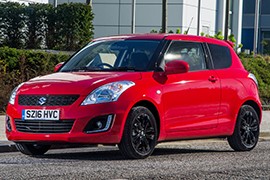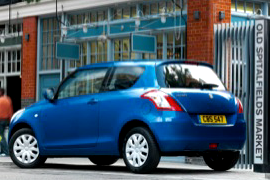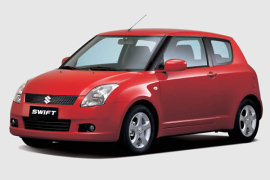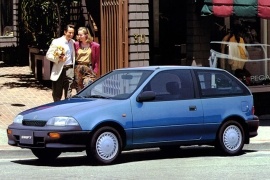SUZUKI Swift 3 Doors Models/Series Timeline, Specifications & Photos
First production year: 1991
Engines: Gasoline, Diesel
Body style: Hatchback
Suzuki introduced the third generation of the Swift in 2010. Four years later, the Japanese carmaker refreshed the entire lineup and added a few technical improvements.
The Swift was initially introduced in specific markets in 1983, and it was marketed in several markets with different names and brands, including the Geo Metro in the U.S. In 2004, Suzuki made a bold move and introduced a new global model, which it claimed was the first generation. But it was just a marketing strategy, and that's why on some markets, the MKI Swift appeared only from 2004 on. The 2014 Swift was a refreshed version of the global second Suzuki supermini vehicle, and it was offered as a three or a five-door hatchback.
There were some minor restyling changes on the outside, including an L-shaped daytime running lights in the front bumper. The three-door version featured a more pronounced ascending beltline toward the C-pillar. The B-pillar was blacked out, so it created the illusion of a wrap-around window area. The carmaker installed new taillights in the rear with the same shape and size as its previous version.
Inside, the three-door Swift featured a new audio system with Bluetooth connectivity and a sat-nav system available on the options list. Like its non-facelifted version, the 2014 model featured bucket-seats at the front installed up from the floor to make room for rear passengers.
Suzuki improved the technical side with the introduction of the AWD version for the 3-door hatchback. Another improvement was the new 1.3-liter DDiS unit, which got a slightly better fuel-efficiency. All engines were paired to a five-speed manual. The top of the range model remained the 1.6-liter Swift Sport version.
Unlike its 5-door sibling, the Suzuki Swift 3-door was offered with a different engine choice. The 3-door version traded the practicality of a car with doors in the back for a sportier image.
The Suzuki Swift was built into a factory in Hungary and it was designed to fight in the small segment of the European market. Its image on the market was good, with great values for its reliability factor. Its simple design from the previous generation evolved a bit, but it wasn't that complicated either.
The short front side of the car with rounded hood and curved triangular headlights were part of a sporty image. To keep the car short, the A-pillars were not too raked to the rear. A straight roof and a sharp drop in the back completed the image.
Inside, the 3-door version kept the features that made the Swift pleasant for its customers. It didn't feature some fancy options. It offered a decent climate control system, an infotainment unit on the center console, and a Japanese-style instrument cluster. The seats in the front were high when compared to a sporty hatchback, but it was necessary to offer them like that for the rear passenger legroom. A small trunk was offered, and it was enough for the weekly shopping.
Under the hood, the 3-door Swift was offered with just two engine choices: a 1.2-liter and the 1.6-liter for the Swift Sport. The former was mated to a 5-speed manual, while the latter was linked to a 6-speed manual.
Suzuki unveiled the fourth generation of the Swift at the Paris Motor Show with a three and a five-door version, specially designed for the European market.
The Japanese carmaker already had a factory in Hungary, and after an unsuccessful WagonR and SX4 lineups built for Europe in cooperation with other carmakers, it decided to go on its own and develop the Swift from the ground up and sell it on the small-segment. Thus, it matched the saying, "If you want a job done right, then do-it-yourself". It was a major step forward for Suzuki, and the result matched the expectations.
With its rounded shapes and vertical, swept-back headlights, the Swift stood apart from its competitors due to its high greenhouse and tall door panels. Its blacked A- and B-pillars made the car looked like it had a floating roof. Its 3.7m (12.14 ft) length qualified it as a city vehicle, while its 2.4m (7.8 ft) wheelbase was just 10 cm (4") shy of a Golf MK4's. The three-door version offered easier access inside the car and small, fixed windows for the rear passengers.
Inside, Suzuki used its kei-car experience and installed tall seats that led to plenty of legroom for both front and rear passengers. Even though it was often criticized for the driving position, many of its customers were happy since they were shorter and could see better than in most of the other city-segment vehicles.
Suzuki installed a choice of four engines under the Swift's hood. While the 1.3-liter and 1.5-liter gasoline engines were shared with its five-door sibling, the 125 hp 1.6-liter unit was installed exclusively on the three-door Swift. A 1.3-liter turbo-diesel engine was carried over from Fiat and offered for the entire range.
Suzuki tried its best to create an affordable yet well-equipped vehicle for the European market and improved its small-segment car, the Swift.
In its three-door version, the Swift was not a pocket hot-hatch. It was more of a cheaper way to offer motorized mobility to its customers. It was also an excellent vehicle for small delivery companies, especially since it was one of the least expensive cars on the European market worth buying it.
The base trim levels still kept the black, unpainted, plastic bumpers, and the Japanese carmaker improved them for the upper versions. They sported a new grille at the bottom, which looked like an air-intake for a sports car, for the full-options version. Its rear pop-out rear windows allowed more air in the cabin, which was a good idea for the versions without air-conditioning.
Inside, Suzuki carried over most of the Swift's parts from the 1991 model year. Since it started to use more European suppliers, the materials fulfilled their new customers' tastes. The dashboard was slightly upgraded and included new materials. To provide better comfort, Suzuki offered air-conditioning on the options list plus front power windows.
Under the hood, Suzuki kept the same engines as before but upgraded to Euro 2 emission standards, which were mandatory starting with January 1997. Also, the 1996 Swift received an option for ABS and even an automatic transmission.
This small-sized Suzuki was available under different names across the Globe, but in Europe, it was known as the Swift, and the automaker made it in three body versions there.
With an increased demand for affordable cars, the Swift proved to be an excellent recipe for the Japanese brand. Apart from the five-door hatchback and the four-door sedan, the automaker also produced the Swift as a three-door hatchback. This version was not only more affordable but also looked sportier and thus more appealing to young customers.
The design was simple, with rounded panels and shaved edges. At the front, it featured a black, plastic wrapped-around bumper and a pair of horizontal headlights with corner-mounted turn signals. Its narrow grille was just enough for the small engines installed under the hood. Its profile showed the tall side windows related to the car's height and the long doors that were needed to ease the ingress and egress of the rear-seat passengers. It sported black mirror caps and door handles. The slightly curved, vertical tailgate ended above the taillights, making loading and unloading difficult.
Inside, it showed low-mounted slim seats at the front. Its new dashboard design was simple and flat, with a raised area for the instrument cluster. On the center stack, depending on the options, it was available with air-conditioning and a tape player. As expected, the tilt-forward front seats allowed passengers to get inside on the rear seats.
Under the hood, Suzuki installed a choice of two gasoline engines paired with a five-speed manual. For specific markets, it offered a four-speed automatic transmission.




